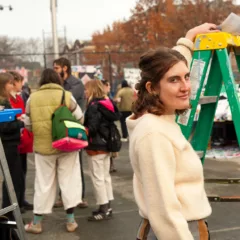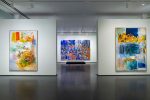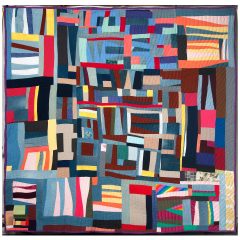In our family annals, this will go down as a great year. Alex got married to Lindsey (video trailer link at the end).

And Murray and I were in San Francisco last week on a top secret mission for great event number 2–according to our lights. Minna was turning 30 and we decided to surprise her with what we assume is the best birthday present ever–us. OK, so not everyone is that crazy about their parents. But we are happy to delude ourselves into thinking she thinks we’re great.
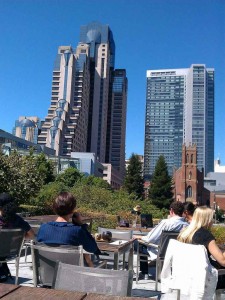
The surprises–us and more–were all arranged by Minna’s husband, Ben, although we do confess to offering ourselves up as surprises before the idea was a gleam in Benny’s eye. First there was a dinner with surprise guests, including us as the appetizer. Two days later we urged Minna to take a walk with us. She stomped her reluctant way to a surprise pot-luck picnic and barbecue with more friends and family, including friends who drove up from L.A. The amount of work making this one happen must be credited to both Ben and friend and neighbor Maryn!
Besides time with family and friends, we also got to hike and to visit museums.

The Archie comics exhibit at The Cartoon Art Museum of San Francisco was great–the jokes stood up over time. Looking at the gang of cheerful kids in that safe environment I remembered why I loved the cartoon–goofy antics and pranks in a fantasy microcosm–a high school social clique in Riverdale, New York. Archie was an ideal that got repeated in teen dating novels all through the 1960s. My own high school experience was nothing like this.
Archie lives on 70 years since its 1941 birth, and Riverdale High has been updated socially with a gay and a black character, and given some political awareness with Obama and Palin characters. But all this is serious revisionism given that Archie was born as a safe harbor from World War II, a suburban fantasy already gearing up, pre-Levittown, to provide psychological safety from life’s ills.
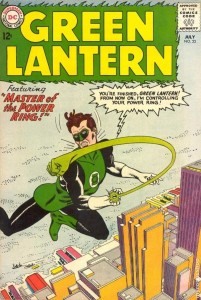
The other retro cartoon on exhibit, Green Lantern, began just a year earlier than Archie. So came out a year before Pearl Harbor. Unfortunately, all the museum presented in both the Archie and Green Lantern exhibition notes were the dates with no context–not a word about how these were fantasies, responses to the realities of a world in turmoil. The best of the Green Lantern drawings–and they were spectacular–were by Martin Nodell and by Gil Kane with Sid Greene. The small museum–a one-floor store front about three rooms deeps–had several other exhibits, including a solo exhibit of works by Lloyd Dangle, a political San Francisco artist who began his career cartooning for Michael Moore’s Michigan Voice. He was the opposite of Archie and Green Lantern–no escapism and no fantasy; plenty of irony.
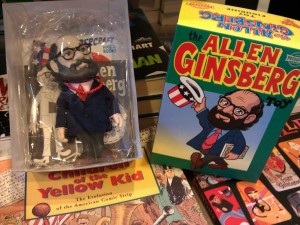
But ultimately it was the gift shop that stole my heart–one of the best museum gift shops I’ve ever been in. Above is the Allen Ginsberg doll, love beads and all! It took great self control not to purchase it.
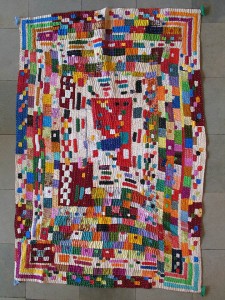
The Museum of the African Diaspora is just a few doors away from the Cartoon Art Museum and I was lured there by the exhibit Soulful Stitching: Patchwork Quilts by Africans (Siddis) in India, where we learned a mess of stuff, like the Africans in India mostly came to Goa in the 1500s, brought there by slave traders.
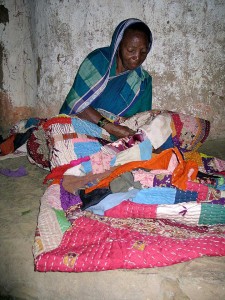
The Siddis adopted many Indian ways, but also retained traces of the culture of their homeland, and the quilts are one example, with exuberant colors, improvised patterning, and running-stitch quilting to pucker the fabric. The piecing, assembled from the outside edge in, is appliqued in layers (the layers become the only inside fabric, no batting) atop sari cloth backing. Here’s a web site selling the quilts.
The exhibit is no longer up. We were there for the last week.
Once we connected with Minna, we went museum-ing with her.
At the San Francisco Museum of Modern Art, we saw two good exhibits there. The exhibit Face of Our Time showcases the work of five photographers–Jim Goldberg, Daniel Schwartz, Zanele Muholi, Jacob Aue Sobol, Richard Misrach–who focus on people living and surviving in a variety of circumstances.
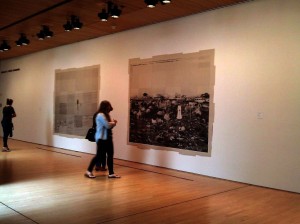
The show begins with Jim Goldberg’s large diptych, two enormous photographic prints telling the tale of one young African man, and his failure to achieve his ambitions. But the second image in the pair, taken the same year, is of a significantly older man. Immediately there’s a disconnect between fact and meaning, a disconnect between literal documentation and capturing a more global story.
The large images are assembled from multiple digitally printed 8 1/2 x 11 inch sheets. And suddenly pixels and small portions of the larger story stretch into the story of an entire people. Along the horizon of each image, the artist has written in two brief parts the tale of the young man and his dreams and then the tale of the dreams dashed. Murray thought the empty sky area above the ocean in the first image was wasted space. We had a discussion about his visual point and my conceptual point (I found a limitless sky, a limitless sea, and the idea of a limitless hope for the future all meaningful). We agreed to disagree.
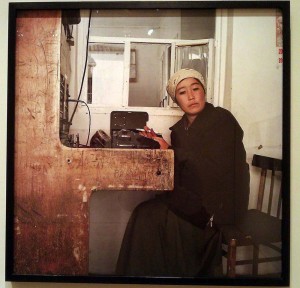
The diptych sets the tone for all that follows. Swiss photographer Daniel Schwartz’ images along the Silk Road also tell larger stories of populations under stress and surviving. A panoramic shot of people shoveling sand to keep the Silk Road clear stunned me with its sweep of desert and the implications of the smallness of we humans and the efforts we must make to resist entropy. In another shot, a woman selling meat is draped in an orange-red fabric veined in white, and market day becomes survival of the fittest day.
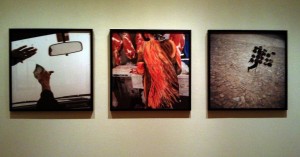
Muholi’s dignified portraits of South African queer women with varying degrees of trans-gender identification announce their place in a culture that abuses them. Also in the show, Misrach’s photos of urgent graffiti messages in post-Katrina New Orleans, and Aue Sobol’s images of life in an Arctic hunting culture. Most of the images are of people who are not mainstream photographic subjects. (Misrach focused on the traces people under stress left behind; people per se were not his subject here). The show is up to October 16.
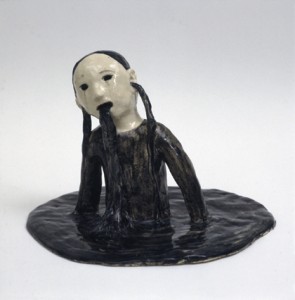
We also visited ceramic figurative sculptures of Tiago Carneiro da Cunha and Klara Kristalova. Kristalova’s fairytale- and story-inspired figures suggest ambiguous, but threatening scenarios. The Czech-born Swedish artist (she moved there in 1968 with her parents after the Russians invaded Czechoslovakia) almost triples the scale of traditional, saccharine figurines and also undercuts their sweetness with terror. Is a girl with black liquid coming out of her ears, nose and mouth melting into her own puddle, like the Wicked Witch of the West or is she just emerging from a deep pool, emitting the excess fluids as she bursts into the air? A girl with a blindfold is either playing a game, or perhaps she is the distraught dupe of a not-so-innocent game, with streaks of black dripping down her face. Some of these are realistically child-size, connecting the fantasy tales to this week’s child-napping, last week’s drowning. The glazes are thick and glassy, adding an inviting, cool tactility to discomfiting imagery influenced by illustrations in children’s books.
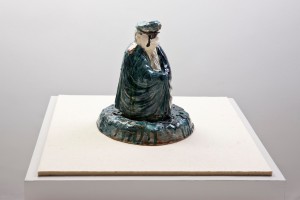
Carneiro da Cunha’s figurines are about half the size of Kristalovas, and reference Brazilian tourist kitsch–gift-shop figurines of saints and national heroes or other gift-shop merch that he told me in a studio visit, a couple of years ago during his residency at University of the Arts, were typical in Brazil. The sculptures are Rabelaisian, bawdy satires of decadence, gluttony and self-importance. My favorite was the figure Ubu, in his dunce cap, wearing a draped gown the folds of which form arches supported by the suggestion of an erect penis, a Pope in his own church (sorry but I have no image available of this).
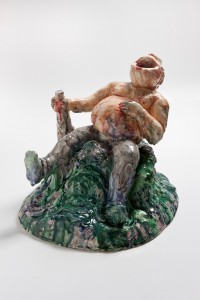
While Carneiro da Cunha’s bestiary of humanity refuses to ingratiate in a very male sort of way, and the artist distances himself from his fellow bully guys, Kristalova does the opposite. She is all ingratiation and identification with these pale girl figures beset. Loved the pairing! The show is up to Oct. 30, and Carneiro da Cunha will be speaking at the museum Thursday, Oct. 6, at 7 pm.
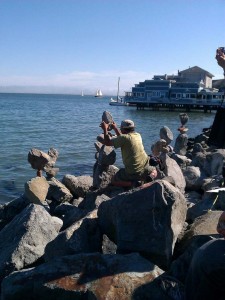
Best of all for this trip, we spent time with Minna and Ben, hiking, eating and just hanging out! I was having such a good time, I didn’t think about taking any pictures.
Oh, and here’s a link to the trailer for Alex’s wedding!


